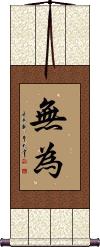Many custom options...
And formats...

無為 in Chinese / Japanese...
Buy an 無為 calligraphy wall scroll here!
Wu Wei / Without Action
Daoist / Taoist Tenet
無為 or “Wu Wei” is a Daoist (Taoist) tenet that speaks to the idea of letting nature take its course.
Some will say it's about knowing when to take action and when not to. In reality, it's more about not going against the flow. What will happen is controlled by the Dao (Tao), for which one who follows the Dao will not resist or struggle against.
You can think of 無為 as the Chinese way to express “laissez-faire.”
There is a lot more to this concept, but if you are looking for this entry, you already know the expanded concept.
Warning: Outside of the Daoist context, this means idleness or inactivity (especially in Japanese, where not everyone knows this as a Daoist concept, though it does pair well with the Japanese concept of Wabi-Sabi).
Not the results for 無為 that you were looking for?
Below are some entries from our dictionary that may match your 無為 search...
| Characters If shown, 2nd row is Simp. Chinese |
Pronunciation Romanization |
Simple Dictionary Definition |
無為 无为 see styles |
wú wéi wu2 wei2 wu wei mui むい |
More info & calligraphy: Wu Wei / Without Action(adj-na,adj-no,n) idleness; inactivity; (female given name) Mui |
無為市 无为市 see styles |
wú wéi shì wu2 wei2 shi4 wu wei shih |
Wuwei, a county-level city in Wuhu City 蕪湖市|芜湖市[Wu2 hu2 Shi4], Anhui |
無為縣 无为县 see styles |
wú wéi xiàn wu2 wei2 xian4 wu wei hsien |
Wuwei county in Chaohu 巢湖[Chao2 hu2], Anhui |
無為信寺 see styles |
muishinji むいしんじ |
(place-name) Muishinji |
無為徒食 see styles |
muitoshoku むいとしょく |
(noun/participle) (yoji) idling one's time away |
無為無策 see styles |
muimusaku むいむさく |
(yoji) do-nothing, plan-nothing (government, etc.) |
無為無聊 see styles |
muiburyou; muimuryou / muiburyo; muimuryo むいぶりょう; むいむりょう |
(adj-na,adj-no,n) boredom; ennui; tedium; wearisomeness |
無為無能 see styles |
muimunou / muimuno むいむのう |
(noun or adjectival noun) (yoji) idle and incompetent; accomplishing nothing significant nor being capable of doing so; lacking the talent to do anything but idle away one's time |
無為自然 see styles |
muishizen むいしぜん |
(1) (yoji) abandoning artifice and just being oneself; doing nothing and taking things as they come; (2) {Buddh} unconditioned nature; unconditioned spontaneity |
無策無為 see styles |
musakumui むさくむい |
(yoji) do-nothingism; do-nothing, plan-nothing (government, etc.); being an idle onlooker taking no steps to meet the situation |
碌碌無為 碌碌无为 see styles |
lù lù wú wéi lu4 lu4 wu2 wei2 lu lu wu wei |
unaccomplished; mediocre; feckless |
The following table may be helpful for those studying Chinese or Japanese...
| Title | Characters | Romaji (Romanized Japanese) | Various forms of Romanized Chinese | |
| Wu Wei Without Action | 無為 无为 | mui | wú wéi / wu2 wei2 / wu wei / wuwei | |
| In some entries above you will see that characters have different versions above and below a line. In these cases, the characters above the line are Traditional Chinese, while the ones below are Simplified Chinese. | ||||
Successful Chinese Character and Japanese Kanji calligraphy searches within the last few hours...




